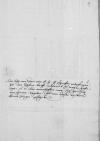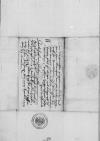Letter #5212
Ioannes DANTISCUS to Albrecht I von Hohenzollern-AnsbachHeilsberg (Lidzbark), 1539-04-26
Manuscript sources:
Auxiliary sources:
Prints:
| ||||||||||
Text & apparatus & commentary Plain text Text & commentary Text & apparatus
 GStA PK, HBA, C1, No. 567, f. 3v
GStA PK, HBA, C1, No. 567, f. 3v
Dem durchlauchten, hochgebornen fursten und hern, hern
 GStA PK, HBA, C1, No. 567, f. 1r
GStA PK, HBA, C1, No. 567, f. 1r
Durchlauchter, hochgeborner furst, / hochgunsstiger, lyber her und freundt. / Unser freuntliche, wÿllige dinst zuvoran. /
Uns ist jesstrigs thages E(wer) F(urstlichen) D(urchlauch)t cf.
Wollen auch in zukunfftiger  GStA PK, HBA, C1, No. 567, f. 1v diss alles mit wirt gefallen, / dan E(wer) F(urstliche) D(urchlauch)t noch unserm vormugen(n) vÿl freuntlicher dinst und wÿllen zu thun, / sein wir alweg geflissen. /
GStA PK, HBA, C1, No. 567, f. 1v diss alles mit wirt gefallen, / dan E(wer) F(urstliche) D(urchlauch)t noch unserm vormugen(n) vÿl freuntlicher dinst und wÿllen zu thun, / sein wir alweg geflissen. /
Datum
Io(an)nes q(ui) sup(ra) ma(n)u p(ro)pria
Postscript:
 GStA PK, HBA, C1, No. 567, f. 2r
GStA PK, HBA, C1, No. 567, f. 2r
Der both, von dem wir E(wer) F(urstlichen) D(urchlauch)t schriffte entpfangen, / het wir dÿsenn briff widerumb zu tragen gefertiget. / So er aber unvorhoffter weis / sich heimlich von hinnen bogeben, / hab wir dÿsen unsern(n) kam(m)er jungen geschickt etc.



